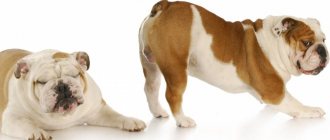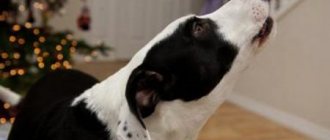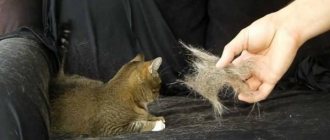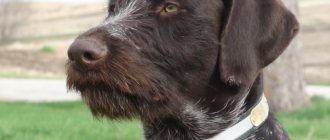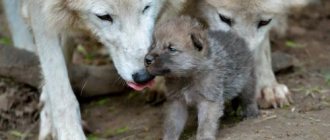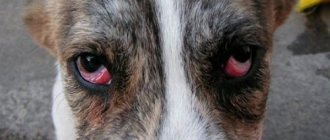- December 22, 2019
- Dogs and hunting with them
- Ekaterina Gordeeva
Once upon a time there was a man who dreamed of a dog with all his soul. Only this person was sincerely perplexed: what is the difference between dogs from elite nurseries and the most ordinary ones bought at the “bird” market or through an advertisement on the Internet? Why pay more for a puppy when you can get it cheaper?
And one day a man bought a dog from an advertisement. Together with the pet, the owner was given a small piece of paper with a seal, explaining that this was a real pedigree. But over time, it turned out that our hero was “cheated”, his dog was a cross between a “bulldog and a rhinoceros”, and his pedigree was “fake”.
Due to the fact that such situations occur quite often in everyday life, the question arises: how to check the pedigree of a dog? This is what we will talk about.
Pedigree is...
When planning to get a puppy, it is worth studying not only the characteristics of the desired breed, but also the nurseries that sell its representatives. Why nurseries with their sky-high prices? Yes, because when buying a puppy there, the owner will receive a real pedigree and will not find himself in the situation described above. It is unlikely that such an owner will have to think about how to check the dog’s pedigree in the future.
Let's start with the very concept of "pedigree". This is a document confirming the purebred of the animal. There are several types of pedigrees.
How to register a pedigree for a dog brought from abroad
In order for a dog brought from abroad to be registered in the RKF system, it is necessary to contact the kennel club with an export pedigree and a certificate of ownership or other title document. After submitting all the necessary documents, the dog owner will receive a Certificate of Registration of a foreign dog with the Verkhovna Rada.
If you encounter any difficulties in the process of registering your pedigree, you can write to us at [email protected] with a detailed description of the problem.
NB! Before applying, be sure to read the full text of the RKF Regulations on breeding work , it contains comprehensive information.
Source
Types of pedigrees
We'll talk about how to check a dog's pedigree a little later. Now it’s worth considering the types of this document:
- An international pedigree is required to take a dog abroad. As a rule, such a document is needed for foreign exhibitions, matings and traveling with your pet.
- RKF pedigree is the most common option. RKF is the Russian Cynological Federation, in which nurseries engaged in breeding one or another breed are registered. The presence of the RKF pedigree confirms the purebred of the pet.
- Pedigree SKOR (Union of Cynological Organizations of Russia). Often, newbie dog lovers have a question: why are SKOR dogs worse than RKF dogs? The fact is that the RKF does not recognize pedigrees obtained from SKOR, therefore dogs from there are prohibited from taking part in exhibitions held under the auspices of the RKF. And SKOR dogs are much simpler in appearance than RKF dogs. To get a SCOR pedigree, it is enough to take the animal to a couple of exhibitions and get positive marks.
Finding a dog's owner in club stud books
Once all the numbers and letters have been identified, it is worth figuring out which of them may be useful. Depending on the order in which the letters and numbers are, as well as how many there are, you can determine in which kennel the dog was born (provided that it is purebred), and contact the breeder and ask for information about the owners. Most often, conscientious nursery owners store this data.
First, it’s worth understanding what brands different cynological federations have, then it will become clear how to find a dog’s owner by brand:
- The mark consists of 3 Latin letters and numbers (their number varies from 1 to 6 characters). Such a mark was most likely given by a breeder or a club - a member of the RKF, and the data is stored in their database. The letters indicate the name of the kennel where the dog was born. By contacting the Federation with a written request (or by email), you can find out the name and contact details of the nursery.
- How else to find the owner of a dog using the RKF mark? The brands of this organization did not always look the same. If the mark consists of 3 Russian letters and any number of numbers, then this means that it was also put by members of the RKF, but only until 2005. If the dog is elderly, then it is likely that data about it can also be found in the Federation database.
- The brand code begins with the letter E, followed by one or two numbers, then any Latin letter and again three or five numbers. A combination of two letters and numbers, these are the marks that are given by the Union of Cynological Organizations of Russia (abbreviated as SKOR). The numbers after the letter E indicate the year the dog was born. The following are serial numbers in ascending order. All information about clubs can be found by writing a letter to SKOR.
- The dog's brand number begins with the letters KW (Kind World), followed by numbers and letters in random order. The mark was put by the International Association of Cynologists “Kind World” (abbreviated as IAC “Kind World”). The brand codes of all association clubs are available for independent search on the official website of the Federation.
It is worth remembering that when sending a written request to any cynological organization, you must indicate the full stamp number, the estimated breed of the dog, color, approximate age and, if possible, attach a photo of your four-legged friend.
The Federation will not send the applicant the address of the alleged owner, but the contact information of the nursery where the dog was born. The breeder usually always keeps the contact information of the dog's owners. Experienced dog breeders claim that a good breeder treats his puppies like children and, most likely, will offer to take care of the foundling and further search for the owner.
Obtaining a pedigree
Before you think about how to check a dog's pedigree, you need to understand how to get it.
The pedigree is obtained through the breeder after the dog reaches 15 months of age. Before this, the main document is the “puppy card” - a kind of pet birth certificate. Once the animal reaches the stated age, the “puppy” changes to pedigree.
Branding of adult dogs
Personal identification can only be applied to young individuals. This is due to many reasons, among which the most important are the following:
- According to Russian law, all animals bred for commercial purposes must be branded before reaching 47 days of age;
- The needle of the claymator is unable to pierce the skin of adult individuals.
If for some reason the puppy was not branded in a timely manner, then in this case an electronic chip is implanted into adult dogs.
By appearance
How to check the authenticity of a dog's pedigree? If the owner holds a document of a certain type in his hands, then he can be sure that the pedigree is real. It's all about the hologram and watermarks, which are noticeable upon closer inspection of the pedigree, as well as in the profile image of the greyhound.
Let's talk a little about deciphering the RKF pedigree. In the center are the dog's details: name, breed, date of birth, brand, color, breeder and owner. The document must contain information about the pedigree and its serial number in the RKF.
Under the numbers “1” and “2” are the dog’s father and mother, followed by grandparents, great-grandparents.
Why do you need to brand a puppy?
The brand is necessary to identify the dog:
- if you want to determine the authenticity of a pedigree and other breeding documents. In this case, the brand acts as a guarantee of the pure breed of the puppy;
- if you have lost documents on the puppy’s pedigree and you need to restore them;
- if the dog is lost or stolen, it is the brand that will allow it to be identified.
- if you want to insure your pet. A clear brand is one of the main requirements for dog owners from insurance companies;
- if you want to take your pet abroad. The customs veterinary service requires a stamp;
- if when purchasing you want to check the age and breed of the dog, its place of residence, origin;
- if you decide to take part in a dog show.
According to the application to the RKF
Is it possible to check the pedigree of a dog (RKF) using the brand number? We will talk about this below. Now let’s talk about such a moment as an application to the specified organization.
Attention! An application can be written only if the pet has the RKF mark, otherwise the owner will be denied consideration of his application.
The application can be submitted electronically on the official website of the RKF, but it is better to go to the organization and write it in person. Of course, this option is only suitable for residents of Moscow and the surrounding Moscow region. RKF is located at:
Moscow, st. Gostinichnaya, 9.
How to find owners for a cat?
How to find new owners for a kitten or cat?
- Write an ad. ...
- Place an ad on websites on the Internet. ...
- Print advertisements and post them around your area, in pet stores, near the subway, etc....
- Publish an advertisement in a newspaper such as "From Hand to Hand" or another classified newspaper.
Interesting materials:
What develops creativity in children? What is the most important thing in the teaching profession? What's the sweetest thing on Earth? What reads information from a floppy disk or writes it to a disk? What's going on in Russian Illusion now? What's going on with Russian novels now? What's wrong with Meryem Uzerli now? What is Dmitry Shepelev doing now? What now instead of the Federal Tax Service? What to sew from velor?
By brand
How to check a dog's pedigree by brand? It's not that easy, but it's quite possible. There are two ways:
- Directly in the RKF itself.
- Via the Internet on special sites dedicated to certain breeds.
If you need to check the pedigree of a dog using the brand number through the RKF, you can call this organization, provide the brand and ask for the pedigree number. This method exists, but rarely leads to positive results.
It is much easier and more effective to check the pedigree of a pet using the brand via the Internet. There are a great many websites - databases that contain information about representatives of a particular breed, and indicate nurseries in whose stud books these animals are registered.
Finding a dog owner through databases
If you don’t have time to wait for a response from the Federation, you can try to find the dog’s brand in the animal database on the Internet, but there is no single database of the RKF or any other dog breeding federation on the Internet. Various Internet pages are filled with amateur dog handlers, often the owners themselves, who leave the details of their pet so that if it goes missing, it will be easier to find it.
There are many databases, this article describes only a few:
- The database of nursery brands on the Infodog website is quite complete, reliable, and equipped with a convenient search. In this database, as a criterion, you can select both the brand and the city or breed in which certain nurseries specialize.
- A constantly updated database on the website of the Zoo Club encyclopedia, numbering more than three thousand brands. In addition to addresses and telephone numbers, it contains not only the stamp numbers that the kennel puts now, but also shows the marks that were put on dogs before 2005.
- The international database Pedigree Dogsfiles is a database of RKF brands that does not have a search tool, but checking a dog’s brand will not be difficult, because the letters of the brand are arranged alphabetically.
- Claws Charity Lost and Found Dogs and Cats File. A resource that helps you find missing dogs and cats, or their owners, animals found on the street. The data comes from ordinary people. It would be a good idea to check the information on this website, maybe they are looking for the dog, or it has already been lost, and volunteers will be able to tell you about its fate.
- The website of the Dachshund land dachshund breeding kennel is a complete database of old and new brands of RKF kennels, you can even try to look for a kennel that is no longer functioning, but perhaps the address and telephone number still belong to the breeder.
- The national electronic identification database combines data on animals not only in Russia, but throughout Europe. In addition to the brand, you can find the owner of the dog if you know the number of the microchip implanted in him. The database contains data about the animals themselves and their owners.
If you find a dog on the street
So we found out how to check the pedigree of a dog by the number (RKF) of the mark. One of the easiest ways is a database provided on the Internet. Therefore, if you find a purebred (at first glance) dog on the street, first of all you need to examine it for the presence of a brand. For large dogs, it is usually placed in the ear or on the stomach. For small breeds - only on the stomach.
Types of branding
There are many situations where a tattoo helped to find a lost animal. In addition, the tattoo provides buyers with the guarantee that they will receive the purebred puppy that they initially chose when inspecting the litter. Also, the branding procedure is mandatory if the dog is planned to be sent to Russian and international exhibitions.
Animal identification is possible in two main ways:
- by tattoo;
- by chip.
The second option is more preferable, since searching for an owner using a dog’s brand takes more time than if an electronic chip is implanted into it. If the animal runs away or is stolen, you can determine its exact location in just a few minutes. However, if breeding purebred puppies is not just your hobby, but also a means of earning money, then applying a tattoo is also desirable, since it can be used to track the dog’s pedigree, which, in turn, will increase its value.
What is a brand?
Usually the brand is the first three letters of the name of the kennel, followed by the serial number of the dog. This serial number is entered into the pedigree, and the pet receives it at birth from the breeder. The breeder registers the newborn puppy in the nursery's stud book, recording its serial number. For example, if the puppy is the 200th born in this kennel, then its number will be “200”.
An example of a nursery brand: LIN 123. We have found out what the numbers and letters mean.
Cost of the procedure
The average price for applying a brand is 100 rubles, but it is important to understand that it may differ by region. If you personally do not want to take the puppy to the kennel, you can call a specialist to your home, but in this case, be prepared to pay about 500 rubles. This is the minimum cost. If you live far from an organization that provides animal branding services, the cost of the operation will be higher. When purchasing a purebred puppy from a kennel, you don’t have to worry about anything, since they apply an identifying code to the dogs immediately after birth.
We are looking for owners
You are lucky, the dog has a mark, and we managed to find out which kennel your find came from. The next step is simpler: we find the website of this nursery and the phone number of the breeder, call him and find out who the owners of the animal are.
If you advertise online that you have found a dog, be careful. “Owners” will come running for free, many want to take a purebred pet “for free,” but you are not a mistake either. Ask potential owners to check the dog's name and brand number.
Chipping
Today, more and more often, kennel owners and dog owners not only brand, but also microchip their puppies. This procedure does not replace, but complements branding. So, a microchip is necessary if you are planning to travel with your pet to Europe, the USA and a number of other countries. In addition, it allows you to quickly identify the origin of the dog. This is especially true in the event of the loss of a pet.
It is, in fact, not easy to check a puppy’s brand from the database, in fact, to establish the authenticity of the code, and therefore the purity of the dog’s breed. Therefore, you should approach the choice of a breeder and nursery very carefully, especially if you are planning to purchase a show or breed class pet. Trust only trusted breeders who are willing to honestly and openly provide all the information you are interested in.
A little about SKOR pets
Do you need to check the pedigree of a dog registered with SKOR? In fact, there are much more problems with such animals than with those registered in the RKF. Why? Yes, because SKOR has simplified requirements for obtaining pedigrees for its dogs, unlike the Russian Cynological Federation.
But this is a small digression. In order to check information about the dog's pedigree number in SCOR, you must follow the verification algorithm in RKF. The ideal option would be to search for the mark in the appropriate database, contact the breeder and subsequently the owner of the animal. But this is the case when we are talking about a found dog.
Where do dog pedigrees come from?
Born from a purebred male and female, a puppy that does not have developmental defects or deviations from breed standards is purebred. This is confirmed by an official document - a pedigree. A kind of family tree - a pedigree - does not guarantee the suitability of a particular dog for service, training, or performing assigned tasks or work. The pedigree only indicates that the puppy was obtained through the breeding line, and there are no other impurities in its “blood”.
Such an official document is necessary in order to gain access to matings, participation in specially organized exhibitions, and further registration of the dog, if the owner wishes, in a dog club of a certain breed. The confirmed origin of the puppy and its purebred allows the offspring obtained from it to be sold at a higher price, which is invariably more profitable for professional breeders.
It is worth noting that getting access to breeding even a purebred puppy with a dog that has a good pedigree is not so easy. A male or female dog that is planned to be used in the future to produce purebred offspring, in addition to its pedigree, must participate in special dog shows, taking prizes at least 2 times.
Regular breeding examinations and passing tests for disciplines appropriate for a particular breed are also mandatory. This is necessary to confirm the working and physical qualities of an individual animal. Puppies will be valued higher, their cost will be higher if the parents are of high rank.
Changes and strict compliance with breed criteria are monitored by specialists from cynological federations and clubs.
Problems when checking pedigree
Alas, representatives of the RKF and other cynological organizations often refuse to provide information about the dog’s pedigree. This is not surprising, since the pedigree is the main document, which, if translated into human language, is the animal’s passport. Who will provide passport data to a stranger? The same is true with the pedigree; it is easier to check the data on an animal by brand than to check the dog’s pedigree using the RKF number. After all, each such document has a specific number assigned to the animal in a given organization. If, of course, the nursery where the dog was born is registered with the RKF.
Search through databases of breed sites and forums
Is it possible to find a dog's owner using a brand in other ways? People often leave their data not in general, hard-to-reach databases, but on breed forum threads and in special sections of websites about animals. If the breed of the found dog is known, it is worth trying to look for contacts of the owner or kennel on the following resources:
- Catalog of representatives of the German Shepherd breed Gsdog is a database of pedigree German Shepherds of the FCI system, whose representative in Russia is RKF.
- The forum for collie and sheltie lovers contains on its pages data from kennels that breed Scottish Sheepdog (collie) dogs. Contact information may be out of date (information was last updated in 2013).
- Russian Retriever Club. There is a sheet with the “prefixes” of labrador retriever kennels. Data on common Labradors may also be available from kennels registered on this site. It is difficult to search - the first letters of the marks are not sorted alphabetically.
- Database of dogs of hunting breeds Huntdogs, a database of brands of dogs of hunting breeds constantly updated by animal owners. All information is divided into breed branches, so if the breed is difficult to identify, the search will become more difficult.
If there's nothing
What to do when you find a dog on the street, but there is no mark or chip? Moreover, it is clear that the animal is purebred, as evidenced by its exterior, but it is impossible to check the presence of a pedigree and find out which kennel the dog is from. In this case, it will not be possible to check the pedigree; you will have to look for the owners in other ways.
One option is to post about the found dog on social networks, taking several photos of the animal. It is advisable to post this post in local city public pages (groups), as well as on free city bulletin boards. You just have to be vigilant, because you never know who will want to introduce themselves as the owner.
In correspondence or telephone conversation with the owner, be sure to ask for the animal’s name, age, and special features. The owner wants to come pick up the dog? Very cool, just let him take his passports with him, both his own and the veterinarian’s. Isn't there any of this? To no, as they say, there is no trial.
What if the owner threatens to write a statement to the police, considering the person who found the dog guilty of stealing it? If there are no documents confirming that the animal is the property of this person, the latter will not be able to do anything. Be that as it may, a dog is property, and property requires certain documents. In our case, a pedigree indicating the initials of the owner.
Where and how are they stamped?
According to the rules of the RKF, the mark is applied in the groin or on the inside of the puppy’s ear. The specific location of the mark (out of the two named) is determined by the breeder or owner himself. In some cases, the tradition adopted for a particular breed plays a decisive role. For example, dogs of those breeds whose ears are usually cropped are marked in the groin.
The brand represents a tattoo. A tattoo is applied to a dog in the same way as to a person. The main tool is the so-called tattoo pen. Sometimes, instead of a handle, a glue gun is used.
The beauty, clarity of the mark, as well as the speed and quality of this painful procedure depend on the skill of the specialist and the quality of his equipment and materials. It is recommended to contact professional specialists.
The procedure for applying a brand can be carried out both in special centers and at home. The location determines the cost of the service. The time for applying the mark is no more than five minutes.
Important! To perform the operation safely, the dog must be securely restrained.
The optimal age for branding a puppy is 45 weeks. It is during this period that a litter inspection report is drawn up and each puppy is assigned a code and brand number. Inspection of litters is necessary to control the breeding of dogs in the RKF.
Attention! With age, the stigma loses clarity. It is the blurring of the mark that proves its authenticity. A clear tattoo on an adult dog may be evidence of falsification.
If your dog is missing
Be prepared for the fact that those who find them will ask for a certain reward for the capture and maintenance of the animal. Of course, you can be indignant, and even contact the police, but anything can happen in life, and there are no guarantees that the dog will not disappear again. And then, if the animal is found by the same people, everything can turn out very badly.
So prepare a reward, the animal’s pedigree, your passport and name the distinctive features of the dog, its name and age.
What does the main set of documents look like?
The documentation provided is divided into veterinary and breeding. The first confirms the health of the dog, and the second confirms its origin. The main kit includes:
- puppy card (metric);
- pedigree;
- act of mating;
- activation;
- veterinary passport.
Important: the pedigree is issued only after 6 months. An attempt to sell a puppy without a metric, but with a pedigree up to the specified age, is considered fraud. . Additionally, the breeder can issue a microchipping certificate.
Additionally, the breeder can issue a microchipping certificate.
Metric, or puppy card
The metric is the second official paper after certification, confirming the purebred of the puppy. It contains basic information about the pet, its parents and owner, confirmed by the seal of the nursery or club.
Along the cut line, the metric is divided into 2 parts. The lower one remains with the owner, and the upper one is transferred to the RKF or another canine organization after 6 months to obtain a pedigree. Until this moment, the puppy is prohibited from being bred, and its participation in exhibitions is limited to two classes: baby and puppy.
Pedigree
The official name of this paper is certificate of origin. It takes 9 months to receive it after the dog turns six months old. Exchange of metrics for pedigree after 15 months is possible, but more labor-intensive.
It is better to find out about the registration procedure through the club at your place of residence or through the RKF. The basic information from the metric is transferred to the pedigree, supplementing it with a barcode and chip number, as well as complete information about ancestors up to the fourth generation. If data is missing in one of the required chapters, the certificate of origin is considered incomplete.
Based on the breadth of action, there are 2 types of pedigree:
- internal (Russian), giving the right to participate in Russian exhibitions;
- export (international), allowing you to attend international exhibition events.
An international sample is issued only if there is an internal one, so it will not be possible to do it right away. It is not necessary to record a family tree for purebred dogs that do not plan to conquer the podium. In this case, the honorary paper will gather dust unnecessarily.
The act of mating
When purchasing, they check the mating certificate, which confirms the fact that purebred dogs were mated. It is drawn up in 3 copies: two of them remain with the owners of the bitch and dog, and the third is transferred to the institution responsible for registering the event. Based on the act of mating, activation is done.
Activation
Within 3 days after the birth of the puppies, the owner of the untied bitch submits information to the club at the place of registration of the pet. Activation is done 1 month after the litter appears. It takes into account the number and health of puppies born, the conditions of their keeping and the presence of a brand. Separately, breed characteristics are prescribed and the first letter used in the puppies' nicknames is determined.
Veterinary passport
Unlike a certificate of origin, a veterinary passport is required for any dog, even a mongrel one. It looks like a small book and contains records of vaccinations and anti-parasitic treatments. In Russia, only one vaccination is recognized as mandatory - against rabies. For free travel abroad the list will be more impressive.
The veterinary passport records, but does not prove the breed. This responsibility falls on the metric and certificate of origin.
How to distinguish fake from real papers
Official documentation is protected by watermarks, coats of arms and holograms, but skilled fraudsters can even forge them. If you want to avoid being scammed, contact only trusted nurseries and avoid purchasing from private sellers.
These papers bear the seals of the responsible institution, the signatures of managers and the emblems of cynological organizations. You can view samples of the required documentation on the RKF website.
Why do you need a pedigree at all?
First of all, in order to have proof of the purebred dog and its belonging to a certain breed. Pedigree is not a panacea for all ills; there are dogs from good kennels with an excellent pedigree, but a problematic psyche. However, this document gives at least some kind of guarantee to the owner.
The second point is what is described above. Pedigree is the main canine document. If an animal is lost or stolen, it will be much easier to return the pet. Dogs registered with the RKF must have a mark, which can be used to identify the nursery where the animal was taken from, contact the owner and return the pet to him.
Training so your dog doesn't get lost
You can reduce the risk of losing your pet if you train your dog properly. To do this, it is necessary to take into account the characteristics of the environment and the nature of the animal.
First of all, your pet must learn such simple commands as “Come to me” and “Stop, stay.” He must master them so well that he can carry them out unquestioningly under any circumstances. Then you don’t have to worry that your pet will be run over by a car, or he will scare those around him, or he will run away in an unknown direction. You should not try to catch up with the dog , shouting after him “I’ll kill you!” Come to me immediately! You should act completely differently - start running away from him, and it is best if you conduct training in a safe place.
What documents do I need to provide?
To register a pedigree for a dog in Russia, as already mentioned, you should first get a puppy card. The information model contains all the features of a particular specimen and even its shortcomings, which affect the breeding value of the dog. As a rule, the document must indicate the breed and name, gender and date of birth, as well as color and brand number.
The available information about the animal’s parents, as well as the full name, passport details and contact information of the owner are immediately entered there. This document is further recognized as valid and used for exchange only if there is a seal and signature of the organization that issued it.
Part of the primary metrics is sent for storage to the Russian Canine Federation, and the other remains with the owner
It is important to preserve it even after receiving the pedigree, since if the main document is lost, in most cases, restoration is possible only if this certificate is available. Although sometimes, when contacting the club, employees issue a second birth certificate, based on the brand applied to the dog’s ear or belly
The puppy metric ends when the puppy is one year and 3 months old.
Some owners are concerned about whether it will be possible to draw up a pedigree if the primary document is missing. In this case, you will only receive a registration or zero paper. Although it confirms the breed of the puppy, it does not give him the opportunity to take part in international exhibitions and be used for mating. A zero pedigree is issued only if the commission confirms that the dog meets the breed standards.
Registered pedigree is done at the club. A prerequisite is a preliminary examination of the dog by three experts certified in this breed. In addition to this information, you will need two photographs - profile and full-face, again signed by the expert. If available, it is worth adding the original of the unconfirmed pedigree
When filling out the metric to obtain a pedigree, it is important to adhere to a simple rule - do everything carefully and correctly, otherwise the organization may refuse to issue this paper
When writing information on all lines, it is important to use block letters written as legibly as possible. If experts misread some symbol and, accordingly, issue an incorrectly completed pedigree, everything will have to be redone
In the line “Owner” the first and last name are written, and in the line “Address” – the currently valid registration indicated in the passport. We must not forget about the index - its absence may serve as a refusal to accept documents.
Puppy metrics are changed in the Union of Cynological Organizations of Russia or in the RKF. Documents issued by other organizations are not considered valid. Pedigrees issued by the RKF are considered more prestigious. They allow you to take part in competitions and exhibitions not only in Russia, but also abroad.
SCOR papers provide the opportunity to act only within the framework of club activities. If the owner of a puppy has completed the paperwork in the Union and then decides to receive confirmation from the RKF, he will have to undergo testing with his pet at three exhibitions and receive assessments from three experts.
To exchange a certificate for a pedigree, today it is not necessary to go to Moscow, since nurseries and city clubs are engaged in mediation. To obtain the document, you must go to the administration of the kennel where the puppy was purchased or to the official city kennel club. Having found out about the possibility of registering a pedigree, you need to pay the receipts and draw up a puppy card. The birth certificate is exchanged for an adult “passport”, which can be picked up in about three months.
